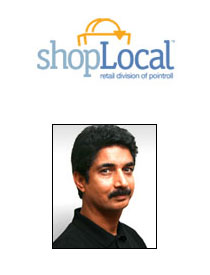 Vikram Sharma is CEO of ShopLocal, a multi-channel online services company.
Vikram Sharma is CEO of ShopLocal, a multi-channel online services company.
AdExchanger.com What problem is ShopLocal solving today?
VS: ShopLocal solves the problem of achieving in-store traffic toward key promotions and deals in an age where consumers have multiple options to purchase that don’t require them to actually physically visit their local Walgreens or JCPenney. By helping retailers connect with consumers both online and in-store, ShopLocal helps to increase brand/consumer engagement and positive brand sentiment.
ShopLocal’s business solutions including SmartCircular, SmartCatalog and SmartDelivery API enable over 100 of the nation’s top retailers, including Target, Best Buy, Home Depot, CVS, Albertsons and Sears to deliver highly interactive, targeted and localized promotions to shoppers through online circulars, display advertising, search, social media, mobile and digital out of home.
What are the advantages of being part of Gannett?
Through the Gannett family we are the retail division of PointRoll, which enables us to connect integrated campaigns that tie in online circulars with rich media advertising and social marketing. Our campaigns deliver more flexibility, reach and opportunity to our customers through the Gannett Digital companies like PointRoll, Ripple6 and the Gannett Digital Network.
Are you able to effectively close the attribution loop from online ads such as your circular to in-store sales?
Yes. The influence of the internet to drive in-store is undisputed. Forrester Research estimates the internet influenced $917 billion (US) in store sales last year alone. There are a number of solutions that exist to demonstrate individual programs influence on store sales. We work with research houses such as Nielson and comScore to show the effect of internet on store sales.
Why is local or hyper local targeting important to your solution?
Local targeting is key for our Facebook marketing solution because circulars are different depending on location. For example, a circular in Alaska may have deals on snow blowers and shovels in March but a circular for the same retailer in Florida will be seeking to drive consumers toward key deals on sandals, dresses and beach wear. It’s all about driving in-store traffic to local stores, so if the circular isn’t relevant to each user, the process is broken. Our goal is to work with retailers who may have a national or even international presence and help them increase and drive traffic to each of their individual locations in order to increase sales and brand engagement across the board.
Can you provide a use case of online circulars in action?
You can check out the JCPenney Facebook example here by clicking the “Store Ad” tab.
When a user goes to JCPenney’s Facebook fan page, it recognizes the user’s zip code, gender and age (if available) and will optimize the products shown that are most relevant to them.
Our latest offering SmartCircular 5.0 was released this week and provides a more personalized circular experience. (See example.)
Do you see a day when ShopLocal can address brand marketers who merely want to drive awareness rather than direct response tactics and branded offers?
Circulars, whether online or offline, are all about driving people to the store to get good deals – by online advertising definitions that is direct response. So I don’t see that part of it going away but I do already see a major shift toward tying direct response and branding together. That is a huge benefit of being the retail division of PointRoll – we’re able to seamlessly tie together branding and direct response vehicles.
How does display advertising play a part of ShopLocal’s strategies? Do you use exchanges for media buying for example?
Our objective is to help advertisers reach consumers wherever they may be on the internet. Display advertising is a huge part of this strategy. The average consumer spends 30 hours on the internet per week. We partner with many leading agencies who as part of their media buying activities work directly with exchanges.
How does ShopLocal benefit the consumer- whether directly or indirectly?
ShopLocal gives consumers easy access to information they’re actually looking for and interested in. On top of that, it helps connect consumers with deals and steals from their favorite brands. E-coupons and sites like Groupon and BuyWithMe are extremely popular right now; consumers are looking to the Internet to connect them with the deals they want. ShopLocal’s technology saves the consumer time by making deals and promotions obvious on sites they already spend a lot of time on (rather than the consumer having to visit each corporate website and search around for deals and products of interest). With the Facebook marketing suite, they can simply log into Facebook, chat with friends, and also find out about great deals from their favorite brands.
With all the intent and transactional marketing data that you are capturing, is it possible that you could re-sell your data at some point through data exchanges whether on behalf of marketers or publishers?
We are not looking to re-sell data. We do use our own data to help retailers find their consumers wherever they may be on the internet. We achieve this via Re-Marketing in display advertising. If a user has viewed the weekly circular online and then later shows up on a publisher website, e.g. USAToday.com, we know what products they have viewed and are able to accurately target product deals based on their past click-stream behavior. We additional work with a number of partners such as Yahoo! to extend the advertising reach.
What milestones would you like the company to have accomplished a year from now?
ShopLocal’s focus is helping retailers to distribute their products to their consumers wherever they may be. Helping retailers to reach consumers on any device or platform including web, social, mobile, display advertising and other emerging mediums such as the iPad. For 2011, ShopLocal priorities are growing our distribution channels, particular in areas such as Facebook, iPad, Android and display advertising to extend the reach of retailers promotions.
Follow ShopLocal (@shoplocal) and AdExchanger.com (@adexchanger) on Twitter.













